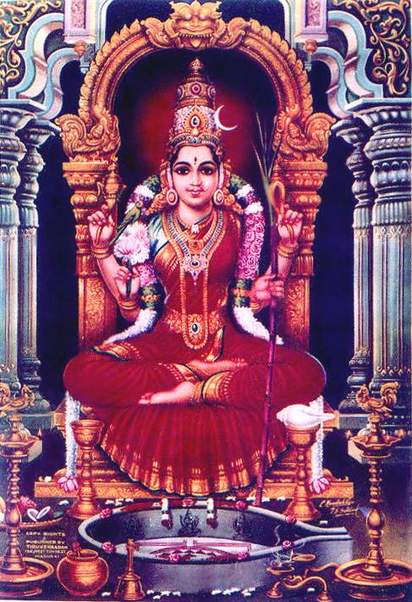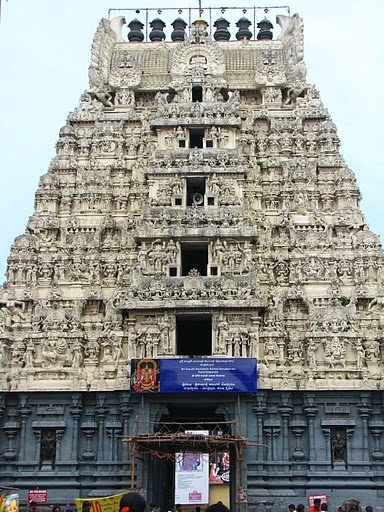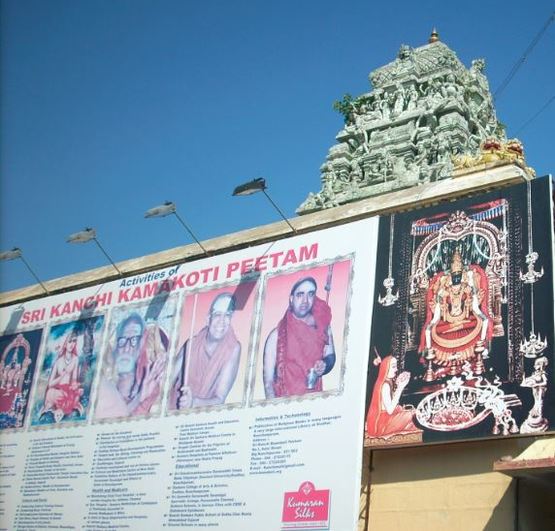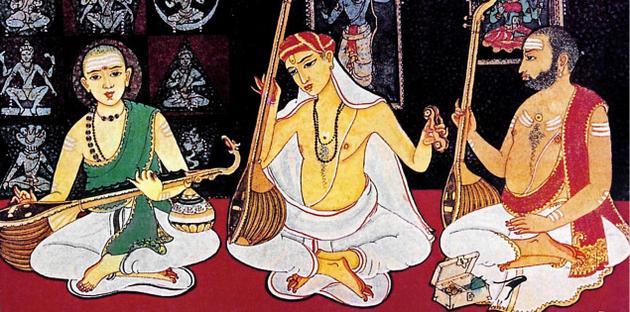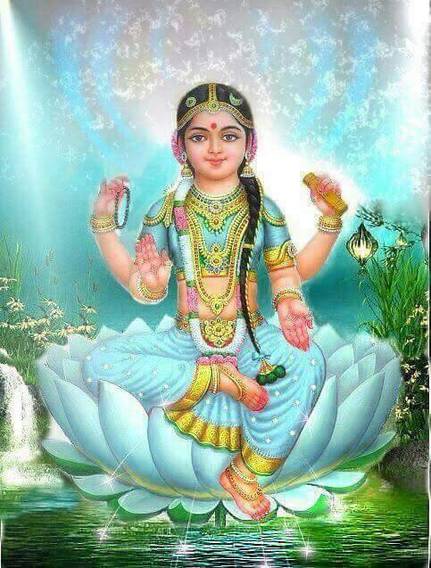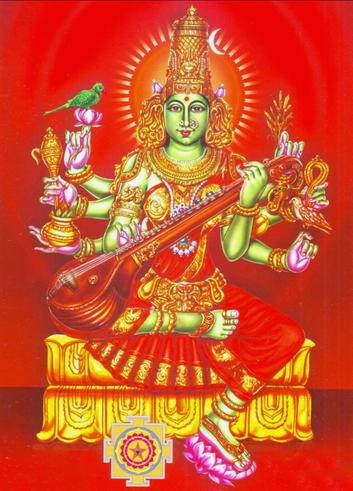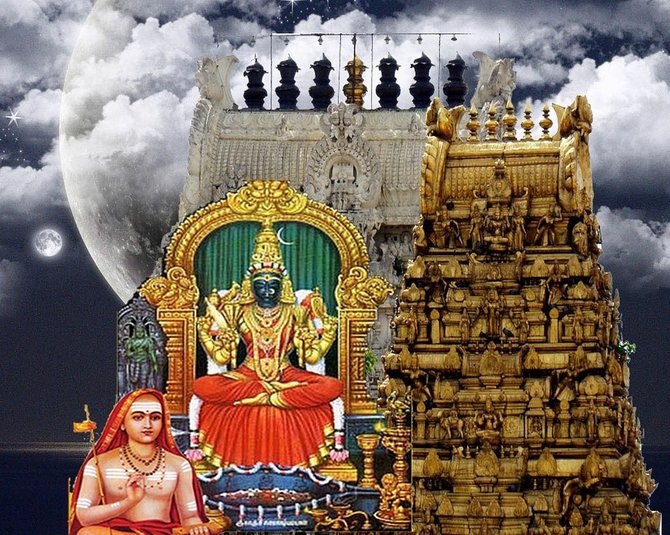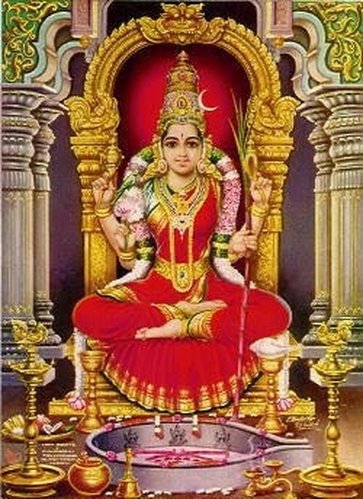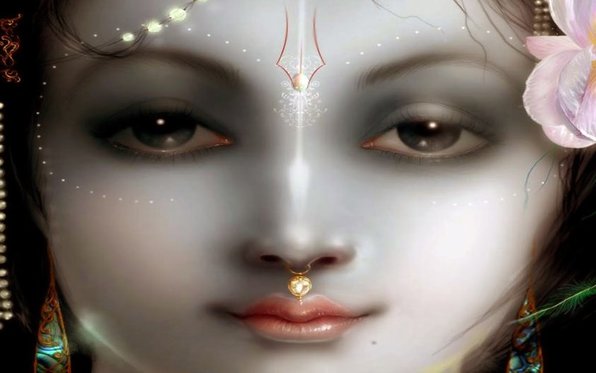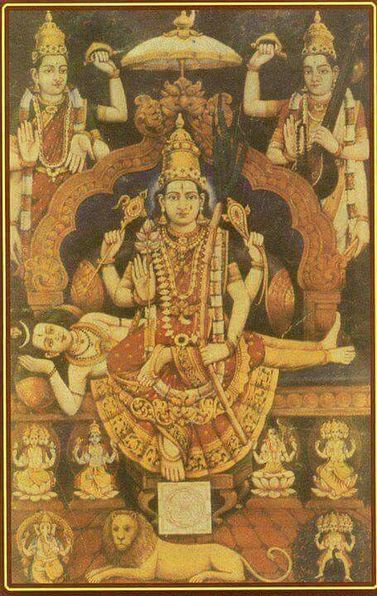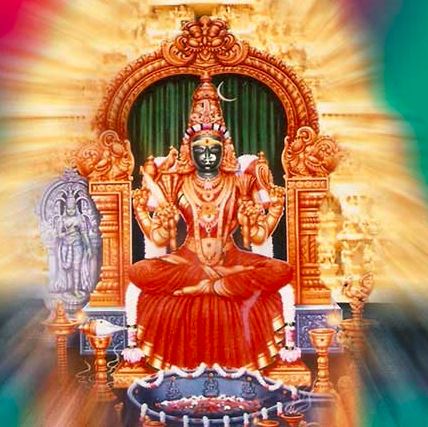Kanchi Kamakshi – A dedication
A devotee had shared his experience of visiting Kanchi Kamakshi temple.
It is his perspective of how one feels when visiting the temple. A divine experience.
Note: He had visited the temple (attended Kamakshi Amma Abhisheka seva) around 2 years back just before the renovation work had started. So some changes might have taken place structurally and what he describes may or may not be the ground realty after the renovation. So please pardon us if we err in our narration of some of the features in the temple and also some of the images used here are not the same pictures as how it looks in Kanchi Kamakshi Temple.
Om Kamakshiye Namaha…
As soon as one reaches the temple premises the first thing which is visible is the main Gopuram with a board proclaiming – Kanchi Kamakshi Temple, Kanchipuram, Shakthi Peetham (Nabhi Sthanam).
It is his perspective of how one feels when visiting the temple. A divine experience.
Note: He had visited the temple (attended Kamakshi Amma Abhisheka seva) around 2 years back just before the renovation work had started. So some changes might have taken place structurally and what he describes may or may not be the ground realty after the renovation. So please pardon us if we err in our narration of some of the features in the temple and also some of the images used here are not the same pictures as how it looks in Kanchi Kamakshi Temple.
Om Kamakshiye Namaha…
As soon as one reaches the temple premises the first thing which is visible is the main Gopuram with a board proclaiming – Kanchi Kamakshi Temple, Kanchipuram, Shakthi Peetham (Nabhi Sthanam).
Once we enter the temple on the left side one can see the gopuram and then we see Tapo Kamakshi. The place where the present Acharya Sri Vijayendra Saraswathi Swamigal stands when he comes for Kamakshi’s darshan. He stands here and meditates for a few minutes. As we enter the temple we can see the Dhwaja Sthambam and a big hoarding with the name “Kanchi Kamakoti Peetham”. Above this hoarding the portraits of Kamakshi Amma, Adi Shankaracharya, Paramacharya, Jayendra Saraswati, Vijayendra Saraswati Swamijis can be seen.
On our left side, we can see a queue for the devotees. There will be an arch with Kamakshi Amma on it and beneath that we see a silver gate. As we enter the gate and stand there waiting for our turn to have the darshan, we can observe people coming out after having the darshan of Lokamatha Kamakshi Amma. As we wait for our contact in the temple to take us inside, on the left side we see the devotees going in for darshan. Just ahead of us we see a picture of three Carnatic musicians to whom people pray before learning music - Thyagaraja Swamy, Muthu Swamy Deekshit and Shyama Sastry.
All three were well known Carnatic musicians who have led their lives with utmost devotion and stood as the gurus in the field of music. Above the picture of the great gurus we can see a big portrait of Bala Tripura Sundari - - in a sitting posture, with Her four hands inviting devotees into the main temple with Her precious smile which can remove all the hurdles in the world.
On Her right side we see Raja Shyamala Devi smiling and in a sitting posture with Her left leg down and right leg folded with ashta bujas (8 hands) and inviting us for the Loka Matha’s Darshan. Paying our obeisance to them we proceed further into the main sanctorum.
Here we again see a big Dhwaja Sthamba. On the right we can see a small rectangular room where the pictures of the Acharyas of Kanchi peetham are visible. We can also see the place where the sandalwood paste would be made for Kamakhsi Abhisheka seva.
Wherever Amma is there can Her children be far off?
On the left before entering the temple we see the Kamakshi’s elder son (Subramanya Swamy) and on the right the younger son (Ganapathi). It is believed both Ganesha and Subramanya take care of their mother.
Wherever Amma is there can Her children be far off?
On the left before entering the temple we see the Kamakshi’s elder son (Subramanya Swamy) and on the right the younger son (Ganapathi). It is believed both Ganesha and Subramanya take care of their mother.
We pray to them and move inside crossing the threshold to the inner temple by placing our right foot inside.
As soon as we enter, on to the right we see the picture of Paramaacharya, the incarnation of Lord Siva, Sri Adi Shankaracharya Sannidhi. Pray to the Jagad guru before moving ahead. We come across a silver gate and a security guard who asks our reference. Since it is Gayathri Mandapam not all devotees are allowed to enter and only devotees who have booked for Abhisheka seva of Kamakshi Amma are given permission to enter into this area.
As soon as we enter, on to the right we see the picture of Paramaacharya, the incarnation of Lord Siva, Sri Adi Shankaracharya Sannidhi. Pray to the Jagad guru before moving ahead. We come across a silver gate and a security guard who asks our reference. Since it is Gayathri Mandapam not all devotees are allowed to enter and only devotees who have booked for Abhisheka seva of Kamakshi Amma are given permission to enter into this area.
We go beyond the gate and wait for our chance to be called into the sacred Gayathri Manadapam. Meanwhile looking around we see Lord Ayyapa who is the Kshetrapalaka of Kamakshi temple (Here Ayyapa is with his wife Poorna Pushkala) and is referred as Dharma sastha. He carries a whip in his hand. It is said that unless we get His permission no one can enter Kamakshi temple and He allows only those people who have utmost devotion to His mother Kamakshi.
Before entering into the Gayathri Mandapam we see a board asking us to remove our shirt. Many Tamilnadu and Kerala temples follow the tradition that one should wear an appropriate dress while visiting a temple. We then come across the gold mandapam in which Kamakshi Amma is seated and blessing all of us. Our hearts jump with joy seeing our mother. Suddenly we get a call from one of the priests to enter the temple.
With happiness in our eyes that at last we would be seeing our beloved mother we enter the most sacred place, the Gayathri mandapam. We see devotes coming out after having Amma’s darshan. Once we enter on the left side we see Chora Krishna. On the right side we see a room in which Kamakshi Amma’s clothes (Her sarees) which are worn by Her are stored. We observe that Gayathri mandapam consisting of 24 pillars as mentioned in the shastras.
We go further and see Her Vaahan (Vehicle) the Lion prostrating before Her. We want to have a quick glimpse of our mother but Amma makes us wait as the curtain before Her is closed. We take a seat and sit there comfortably waiting for our chance to see Kamakshi amma. In the mean time looking around we have a glimpse of the Gayathri mandapam, all the pillars, and other devotees waiting to have darshan. Archakas come from outside with a plate in their hand which consists of kumkum and aarthi. They also wait patiently for the curtain to open so they can offer aarthi to Amma and then offer to the devotees who are waiting outside.
With happiness in our eyes that at last we would be seeing our beloved mother we enter the most sacred place, the Gayathri mandapam. We see devotes coming out after having Amma’s darshan. Once we enter on the left side we see Chora Krishna. On the right side we see a room in which Kamakshi Amma’s clothes (Her sarees) which are worn by Her are stored. We observe that Gayathri mandapam consisting of 24 pillars as mentioned in the shastras.
We go further and see Her Vaahan (Vehicle) the Lion prostrating before Her. We want to have a quick glimpse of our mother but Amma makes us wait as the curtain before Her is closed. We take a seat and sit there comfortably waiting for our chance to see Kamakshi amma. In the mean time looking around we have a glimpse of the Gayathri mandapam, all the pillars, and other devotees waiting to have darshan. Archakas come from outside with a plate in their hand which consists of kumkum and aarthi. They also wait patiently for the curtain to open so they can offer aarthi to Amma and then offer to the devotees who are waiting outside.
The main Archaka goes inside and claps. Immediately the curtain opens and in a flash we see our mother Kamakshi Amma sitting in a padmasana (yoga asana) with four hands and smiling at Her devotees who have come to have Her darshan. As soon as we see our mother, tears start rolling from our eyes.
We are seeing our Mother Goddess after so many days. We have seen Her before entering our mother’s womb when we are a micro-organism waiting for our turn to take birth on this earth. Before that She was the one who took care of us. As soon as we get Her darshan our happiness doubles. Her smile tells us all – ‘Oh! My child you have come all the way to see Me! I am always with you! Do not cry! Just look at me, and I will take care of you! No matter what, I will always be with you!’
There are no words to describe Kamakshi Amma. However I will make a small attempt to say a few words. Amma is sitting in padmasana with Her top two hands holding of Raga and Pasham. Whoever touches Her feet will be coming out of the worldly pleasures and will attain moksha. The other hands hold 5 arrows and sugar cane bow. Manmadha has a similar bow but the major difference between the two is --- the bow of Manmadha will be directed to kamam (desire and greed) but the one which our mother holds will help us overcome these worldly desires and ultimately reach the feet of our Father (Lord Shiva) .
We are seeing our Mother Goddess after so many days. We have seen Her before entering our mother’s womb when we are a micro-organism waiting for our turn to take birth on this earth. Before that She was the one who took care of us. As soon as we get Her darshan our happiness doubles. Her smile tells us all – ‘Oh! My child you have come all the way to see Me! I am always with you! Do not cry! Just look at me, and I will take care of you! No matter what, I will always be with you!’
There are no words to describe Kamakshi Amma. However I will make a small attempt to say a few words. Amma is sitting in padmasana with Her top two hands holding of Raga and Pasham. Whoever touches Her feet will be coming out of the worldly pleasures and will attain moksha. The other hands hold 5 arrows and sugar cane bow. Manmadha has a similar bow but the major difference between the two is --- the bow of Manmadha will be directed to kamam (desire and greed) but the one which our mother holds will help us overcome these worldly desires and ultimately reach the feet of our Father (Lord Shiva) .
We can see Kamakshi smiling like a small girl (many devotees feel She is a small girl as mentioned in the Lalitha Sahasranamam). On Her right shoulder, we see a small parrot (it is believed that Gods come in the form of parrot to worship Her). We can see Her earrings which gives good prosperity and mangalyam to all the married women in the world. We see Her divine eyes (Kamakshi’s eyes will not be straight as we see in the photos, it will be on the left side). The Archaka Swamy goes inside and offers Her aarthi, keeping the aarthi plate near Amma’s eyes. And yes She will rotate it whenever the Archaka places the aarthi plate before Her. Many devotees who have been blessed by Her were able to see the rotation of Her eyes. It happens for a split second only. We can see Amma turning Her eyes for a moment, from left to right and again moving back to the original position.
On both sides of Kamakshi we see oil lamps which give the brightness to see our Amma (many temples have only oil lamps, they do not prefer electric bulbs). To the right side we can see Tapo Kamakshi with Her left leg folded. She came to earth to pray for Lord Shiva and Shiva came in the form of Ekambreshwar to marry Her. From the place where we sit we can see another room in which Sri Adi Shankarachraya established Sri Chakram. It is a huge one with all the Gods on it. When Archaka comes and asks us to follow him, we stand up, offer our pranamams and request Her to fulfill our wishes and also appeal for punah darshan at least in our dreams. We then follow the Archaka to the left side of the Gayathri Mandapam. We will be given some Kumkum and we have to take that to the corner where Aroopa Lakshmi (a form of Lakshmi Devi) will be there. We have to apply kumukum to Her (This is done to remove the curse given by Vishnu to give Her back the original roopam, without applying to Her we should not bring back the Kumkum).
While coming out we can see two statues of Ganapathi (Sowbhagya Ganapathi and Santhana Ganapathi). We also see a pillar called the Dasaratha pillar installed by King Dasaratha (father of Lord Rama). As he did not have any children he came and worshipped Kamakshi Amma and installed a pillar. Amma in turn with Her four hands blessed him with four sons, whom we all know (Ram, Lakshman, Bharath and Shatrugna). We touch the Dasaratha pillar (if couples who do not have children touch the pillar with utmost devotion, they will surely be blessed with children). In the Dasaratha pillar there is Nabhi Stanam (Shakti Roopam). After praying to it we come out again to have a glimpse of our mother. Although we do not want to leave the place we come out unwillingly. While coming out, on to right side we see the Mahalaksmi (we applied kumukum to Aroopa Lakshmi and Her curse was removed and She obtained Her original form). To check whether his wife is following the procedure to remove the curse, Lord Vishnu will be watching like a thief (hence called Chora Krishna) whom we can see in a mirror installed over there. We come out of the Gayatri Mandapam, turn right and walk forward to have one more darshan of Kamakshi from outside. We take a few steps more and climb the steps.
While coming out we can see two statues of Ganapathi (Sowbhagya Ganapathi and Santhana Ganapathi). We also see a pillar called the Dasaratha pillar installed by King Dasaratha (father of Lord Rama). As he did not have any children he came and worshipped Kamakshi Amma and installed a pillar. Amma in turn with Her four hands blessed him with four sons, whom we all know (Ram, Lakshman, Bharath and Shatrugna). We touch the Dasaratha pillar (if couples who do not have children touch the pillar with utmost devotion, they will surely be blessed with children). In the Dasaratha pillar there is Nabhi Stanam (Shakti Roopam). After praying to it we come out again to have a glimpse of our mother. Although we do not want to leave the place we come out unwillingly. While coming out, on to right side we see the Mahalaksmi (we applied kumukum to Aroopa Lakshmi and Her curse was removed and She obtained Her original form). To check whether his wife is following the procedure to remove the curse, Lord Vishnu will be watching like a thief (hence called Chora Krishna) whom we can see in a mirror installed over there. We come out of the Gayatri Mandapam, turn right and walk forward to have one more darshan of Kamakshi from outside. We take a few steps more and climb the steps.
After climbing the steps we come across the statue of Sage Durvasa who prescribed how the rituals should be done in the Kamakshi temple. To the left we see the Sayana Mandap (where Kamakshi will be sleeping every night). We walk further and come across Ganesha to whom we pray. We again take a right and go further. While walking, on the walls we observe Abirami (written by the great devotee Abhirami Bhattu). A few steps more to our right we can see the Utsava Kamakshi with Lakshmi Devi to Her left and Saraswathi Devi to Her right. Devotees who offer prayers to Kamakshi will be blessed by Lakshmi and Saraswathi as well. Opposite to Utsava Kamakshi we can see Thundeera Maharaja (Amma’s devotee, we should never stand in between them).
The interesting thing is at one point we can have darshan of five Kamakshi Roopams.
First Kamakshi, main deity which is straight ahead, the second one Utsava Kamakshi, third gold Kamakshi (Gold padukas installed by Paramacharya), fourth Tapo Kamakshi beside the main deity and the fifth Kamakshi on the roof.
First Kamakshi, main deity which is straight ahead, the second one Utsava Kamakshi, third gold Kamakshi (Gold padukas installed by Paramacharya), fourth Tapo Kamakshi beside the main deity and the fifth Kamakshi on the roof.
We move to our left and take another right and worship gold padukas (gold Kamakshi). We walk outside and come back to Adi Shankaracharya shrine. We offer prayers to him and follow the steps to come out of the temple. We then perform the Sastanga namaskaram near the Dhwaja sthambam (nowhere in the temple are we allowed to do sastanga namaskaram/ prostration). We then start the pradakshina of the temple starting from the left side of the dhwaja sthambam. On to the right side we see the Vahanas (vehicles for Kamakshi Brahmotsavam). We also see a small building where the naivedyam is prepared for Amma. When we take another right turn, we see a number of parrots sitting there (All the Gods are believed to come for Kamakshi darshan in the form of parrots). We walk further and to left we can see drinking water and on the right side Pushkarini (sacred pond in which Paramacharya was felicitated with gold coin Abhishekam). On walking further we then see the second raja gopura (towards our left) as well as the third and fourth raja gopurams. Few more steps we see a big hall (Navarathri celebrations are held in this hall). We then take a right, stand there and offer our pranamams to Kamakshi Gopuram. We can then see a small temple beyond Kamakshi gopuram which has Sri Lord Vishnu in three different positions - sitting, standing and sleeping postures. We walk further to see the Gaja mandapam (where elephants of the temple stay). Another right brings us to the temple of Mahishasura Mardhini. A few steps away we see a mandapam in which Lalitha Sahasra nama parayanam is conducted by priests during auspicious days and festivals. Women from all walks of life participate during all these functions.
We see also a building for the Executive Officer and on the right we see a well from where the Abhisheka water would be drawn every day. We come across a priest giving prasadam. We take prasadam, sit comfortably praying and thanking Kamakshi Amma for giving Her blessing in the form of prasadam. We partake the prasadam and then proceed to where the water is available (left of the Dhwaja sthambam) wash our hands and drink some water. We return to the Dhawaja sthambam and once again prostrate. With a heavy heart, as we don’t want to leave our mother, come out of the temple once again thanking Her for the divine darshan She gave as well as Her blessings.
Thank you Kamakshi Amma.
Sarva Mangala Maangalye
Shive Sarvaartha Sadhike
Sharanye Tryambake Gauri
Naarayani Namosthuthe
Sarva Mangala Maangalye
Shive Sarvaartha Sadhike
Sharanye Tryambake Gauri
Naarayani Namosthuthe

